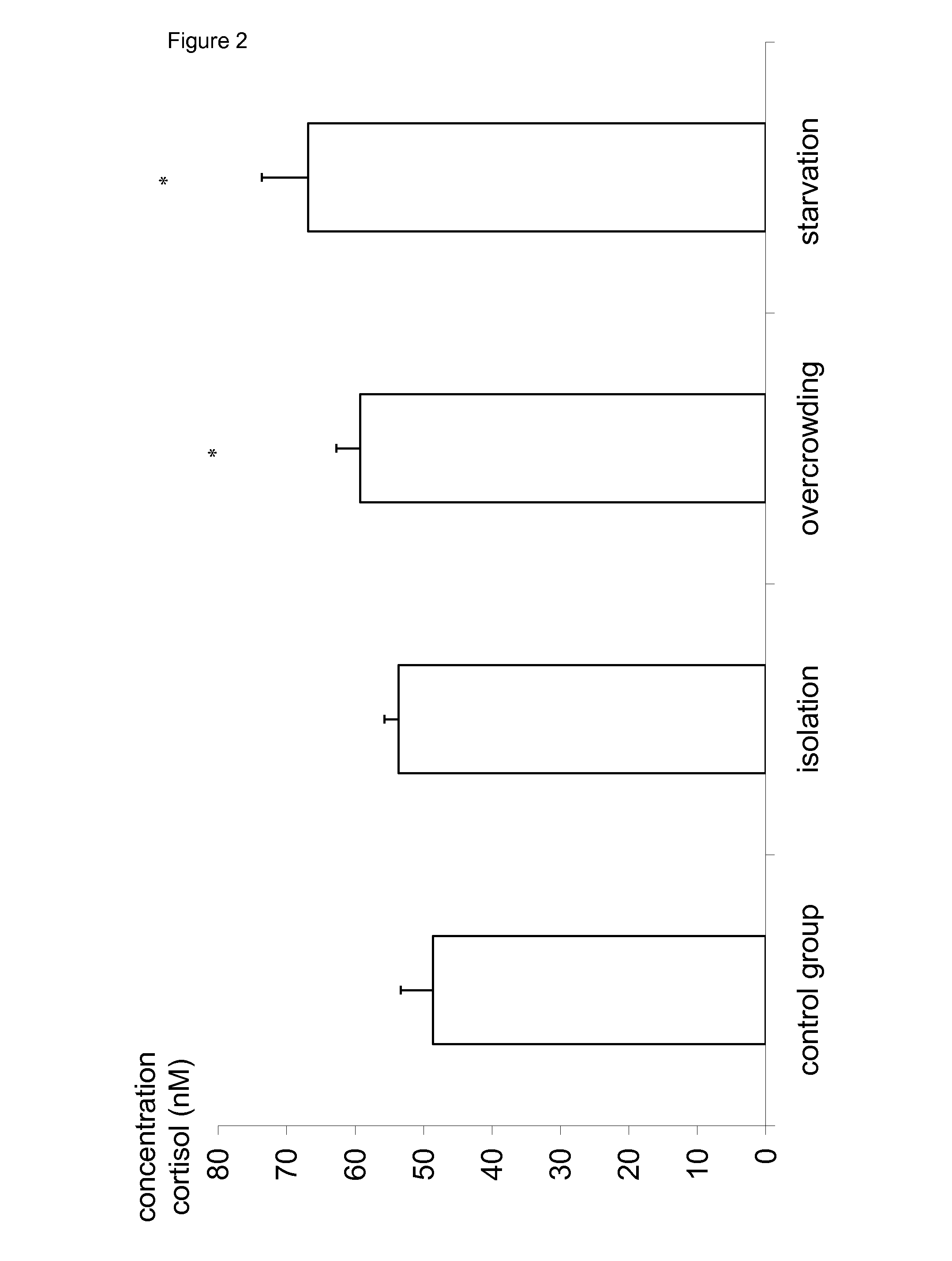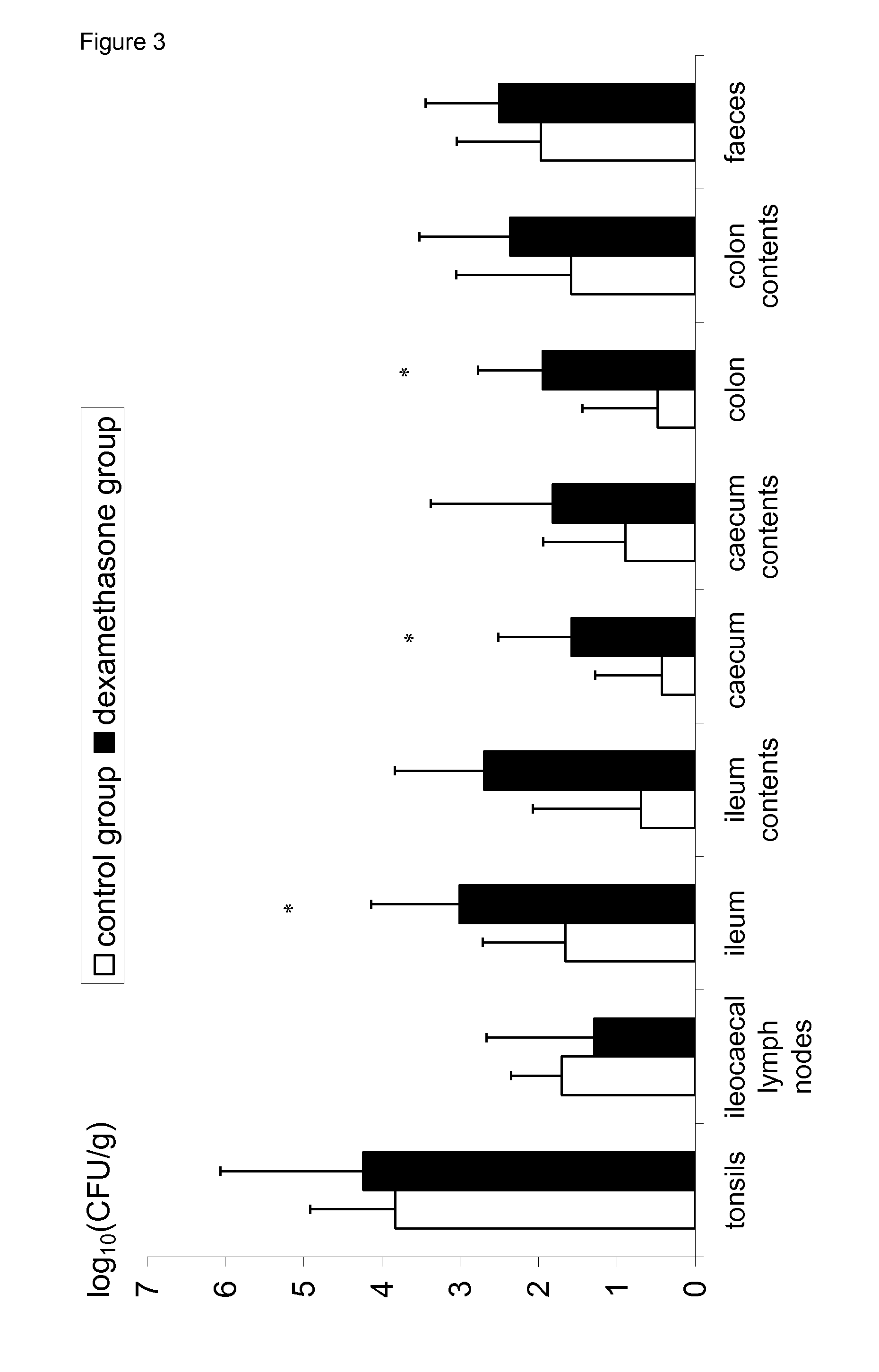Prevention of Salmonella recrudescense
a salmonella and mutant technology, applied in the field of salmonella mutants, can solve the problems of increased cross-contamination, higher degree of carcass contamination, and no current available vaccines confer any protection against salmonella recrudescence, so as to prevent or reduce salmonella recrudescence and increase intracellular survival in macrophages
- Summary
- Abstract
- Description
- Claims
- Application Information
AI Technical Summary
Benefits of technology
Problems solved by technology
Method used
Image
Examples
example 1
Materials and Methods
[0074]1. Chemicals
[0075]Cortisol and dexamethasone (Sigma-Aldrich, Steinheim, Germany) stock solutions of 10 mM were prepared in water and stored at −20° C. Serial dilutions of cortisol were, depending on the experiment, prepared in Luria-Bertani broth (LB, Sigma-Aldric) or in the corresponding cell medium.
[0076]2. Bacterial Strains and Growth Conditions
[0077]Salmonella Typhimurium strain 112910a, isolated from a pig stool sample and characterized previously by Boyen et al. (2008), was used as the wild type strain (WT) in which the spontaneous nalidixic acid resistant derivative strain (WTnal) was constructed (Boyen et al., 2008). For fluorescence microscopy, Salmonella Typhimurium strain 112910a carrying the pFPV25.1 plasmid expressing green fluorescent protein (gfp) under the constitutive promoter of rpsM was used (Boyen et al., 2008; Van Immerseel et al., 2004).
[0078]Unless otherwise stated, the bacteria were generally grown overnight (16 to 20 hours) as a st...
example 2
In Vivo Expression Technology (IVET) Screening for Intracellularly Cortisol Induced Genes of Salmonella Typhimurium
[0130]All the colonies showing low-level lacZY expression were analysed to identify is genes that are intracellularly expressed in PAM that might be essential for Salmonella survival in PAM. In total, we purified and sequenced 287 and 69 colonies from PAM whether or not treated with 1 μM cortisol, respectively. An overview of the identified genes is given in table 1. The represented data are the result of 3 independent experiments for PAM whether or not treated with 1 μM cortisol. Of all genes, only STM4067 was found in all 3 independent experiments and in both conditions. STM4067 encodes the putative ADP-ribosylglycohydrolase, which was identified by Van Parys et al. (2011) as a factor for intestinal Salmonella Typhimurium persistence in pigs.
[0131]CbpA, pflC, pflD and scsA were identified in all 3 independent experiments, however only in PAM that were treated with 1 ...
example 3
Deletion of scsA Results in the Inhibition of the Cortisol Induced Increased Intracellular Proliferation of Salmonella Typhimurium in PAM and in an Upregulation of the scsBCD Operon
[0134]Salmonella Typhimurium deletion mutants ΔscsA and ΔcbpA, were constructed according to the one-step inactivation method described by Datsenko and Wanner (2000) and slightly modified for use in Salmonella Typhimurium as described by Boyen et al. (2006c). Primers used to create the gene-specific linear PCR fragments (cbpA and scsA forward and reverse) are given in table 2. The targeted genes were completely deleted from the start codon through the stop codon, as confirmed by sequencing.
[0135]
TABLE 2Primers used in this study.PrimersSequencescbpA5′-GAAACCTTTTGGGGTCCCTforwardTCTGTATGTATTGATTTAGCGAGATGATGCTTGTGTAGGCTGGAGCTGCTTC-3′(SEQ ID NO: 11)cbpA5′-GTGTGCAAACAAAATTCGGTGreverseATGGTAAAGGTGACAGTGATGTTAGCCATCATATGAATATCCTCCTTAG-3′(SEQ ID NO: 12)scsA5′-CAAAACCGCGCCAGTGGCTAAGATforwardAACTCGCGTTAAACAGTGAGGG...
PUM
| Property | Measurement | Unit |
|---|---|---|
| body weight | aaaaa | aaaaa |
| pH | aaaaa | aaaaa |
| concentrations | aaaaa | aaaaa |
Abstract
Description
Claims
Application Information
 Login to View More
Login to View More - R&D
- Intellectual Property
- Life Sciences
- Materials
- Tech Scout
- Unparalleled Data Quality
- Higher Quality Content
- 60% Fewer Hallucinations
Browse by: Latest US Patents, China's latest patents, Technical Efficacy Thesaurus, Application Domain, Technology Topic, Popular Technical Reports.
© 2025 PatSnap. All rights reserved.Legal|Privacy policy|Modern Slavery Act Transparency Statement|Sitemap|About US| Contact US: help@patsnap.com



